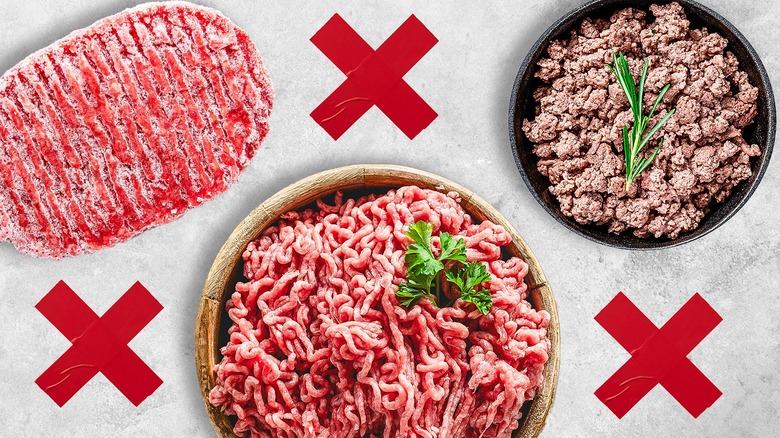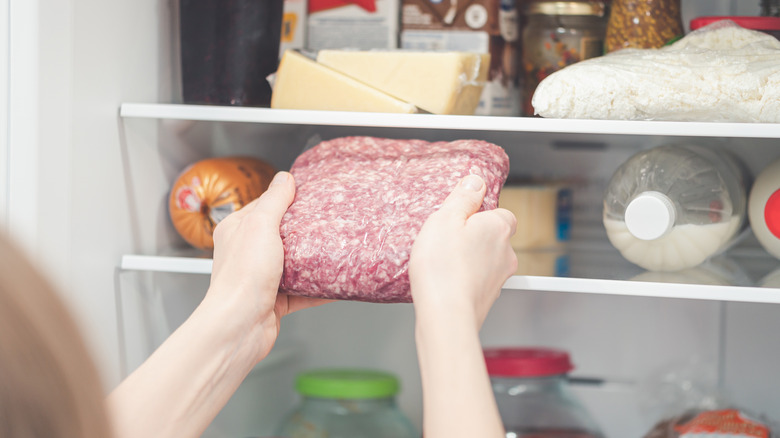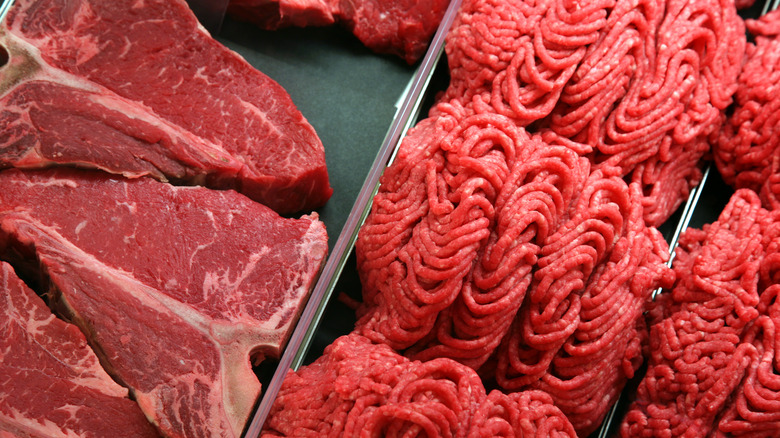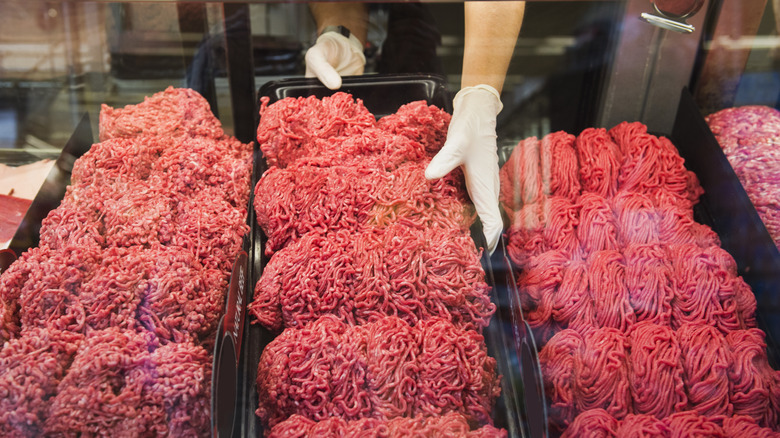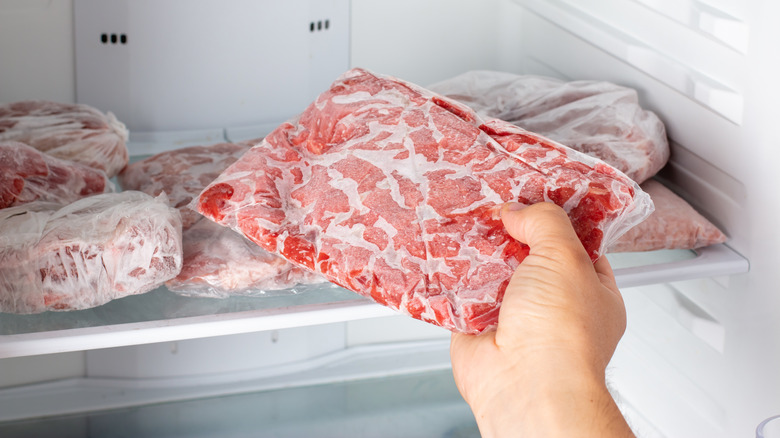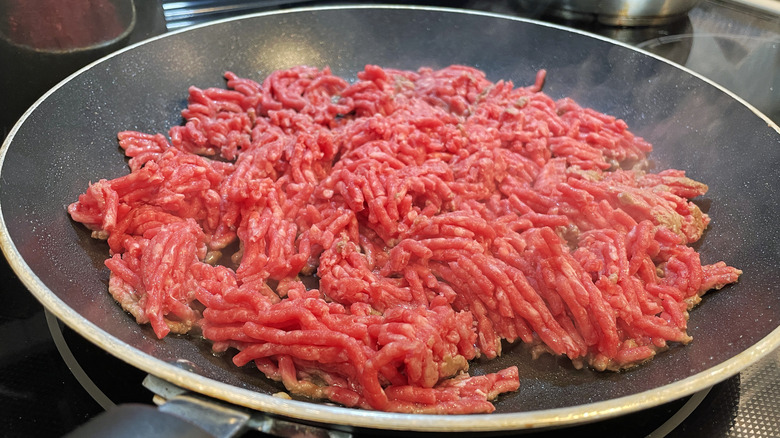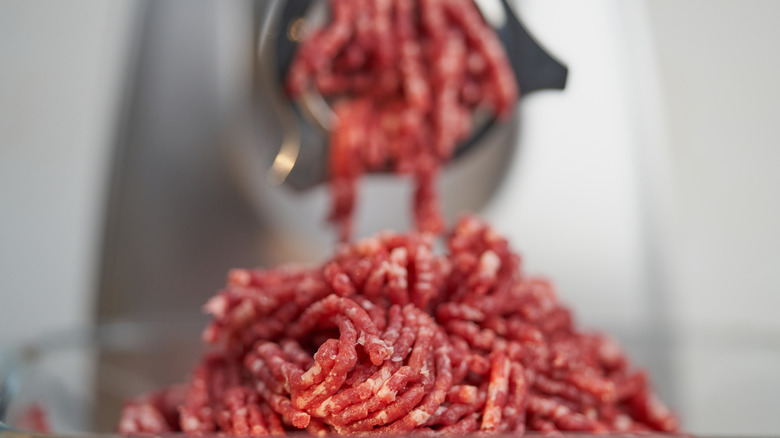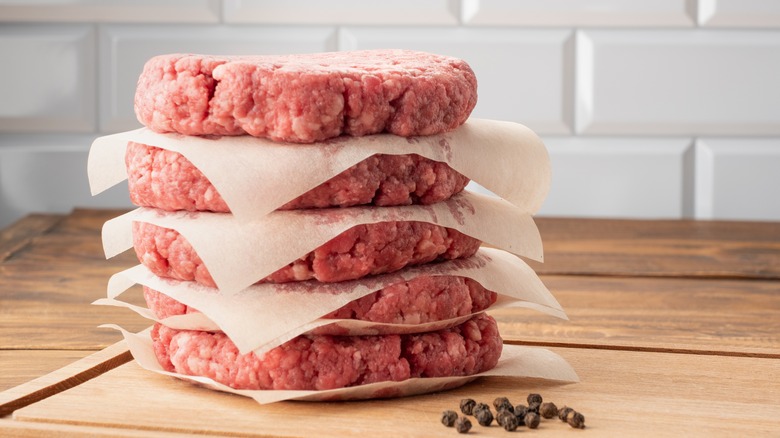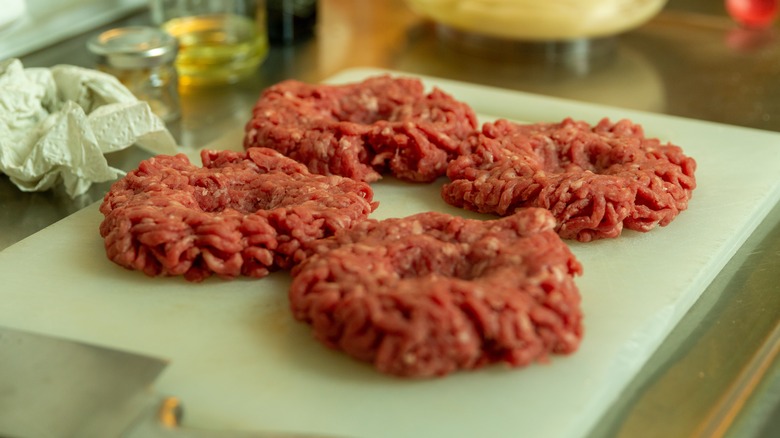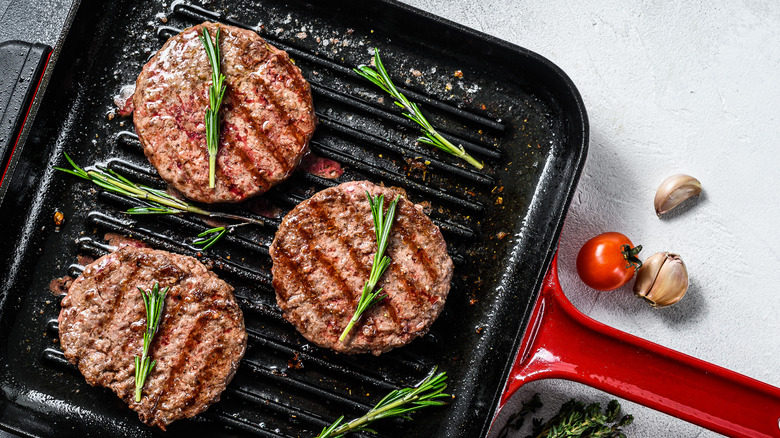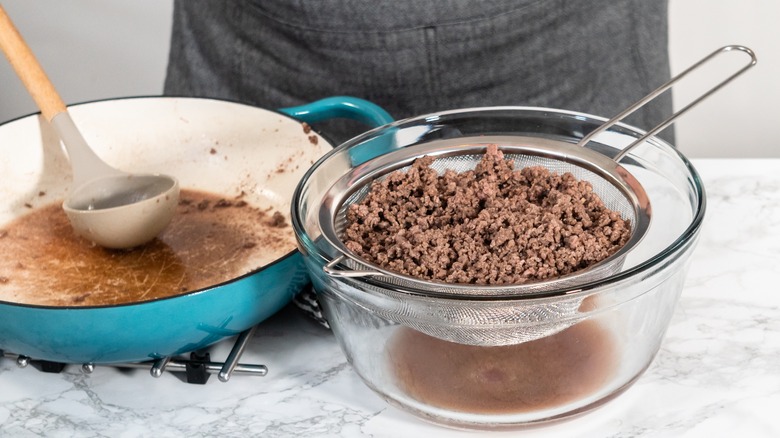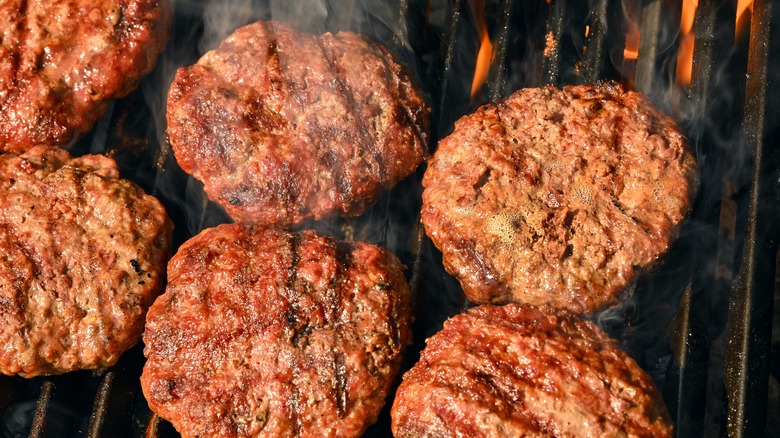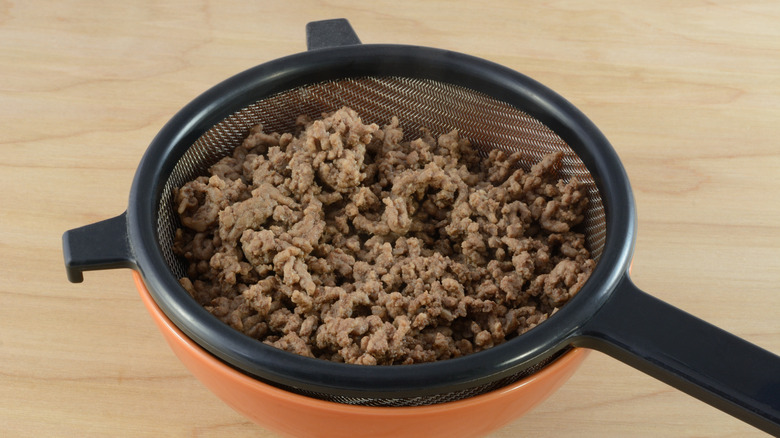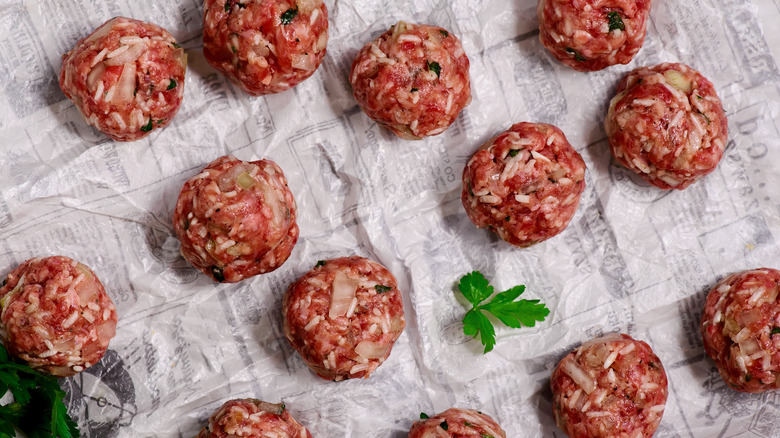Mistakes Everyone Makes With Ground Beef
Ground beef is an essential ingredient in many kitchens because of its versatility in dishes like meatballs, burgers, and casseroles. But there are mistakes in storage, preparation, and seasoning that can turn this handy item into a bland brick. Some of the biggest mistakes that cooks make when it comes to ground beef happen before they even start cooking it. Finding the right blend, cut, and poundage is crucial for some dishes to maximize flavor and achieve the right texture. Other mistakes occur during the cooking process, including some techniques that can cause problems in your home as well as on your plate. The worst mistakes can even make you sick if your ground beef isn't handled safely.
Fortunately, there is a solution to each one of the simple ground beef blunders. Once you find just the right blend, handle it with care, season it just right, and cook it the best way, you'll be rewarded with beef that is delicious, tender, and in demand at any gathering.
Using spoiled meat
One of the biggest mistakes that can ruin your dish — and potentially make you sick — is using spoiled beef. Make sure that you're using fresh meat by checking for indicators of spoilage. You can't just judge the beef by its color, since the freshest meat is naturally purplish and only turns red when exposed to oxygen. It turns brown after being stored in the refrigerator, but that's not always an indication of spoiled meat. An unusual odor and texture are other signs that you can use to determine if your ground beef has spoiled.
It's helpful to pay close attention to "best by" or "use by" dates on the ground beef packaging. If you are storing meat in the fridge or freezer, put the freshest meat in the back and move meat that needs to be used first toward the front. The United States Department of Agriculture recommends that you use ground beef within two days of storing it in the refrigerator or put it in the freezer. If you suspect that the meat has spoiled — either because it shows signs like a bad smell or because it is past the expiration date — it's better to throw it away.
Eating unspecified cuts
Buying prepackaged ground beef is convenient, but you don't always know what cut the beef is from and what you are getting in the package. Some stores and brands label their ground beef, but doing so is not required. Packaged ground beef might also be a combination of cuts, often the less desirable parts or the leftovers from cutting steaks, or other parts of the cow where presentation matters. This isn't always the case, but it does happen more often with ground beef.
For the ultimate gourmet ground beef, have it ground at the butcher counter instead. You can pick out your specific cut right there and watch as the butcher puts it through the grinder. Naturally, this gives you more control over the type of meat you're getting. Some shops also have different grinder settings or blades, letting customers specify if they want coarse, medium, or finely ground beef. If you don't have a specific preference, the butcher can help you decide based on the dish that you'll be making. They can also tell you the cut used for the ground beef already prepared in the case.
Cutting out too much fat
You might think that the leanest ground beef is the best but that's not always the case. Fat gets a bad rap but it's actually necessary to the cooking process to add flavor and keep moisture. Some dishes like burgers need fat to be juicy so opting for a blend that is too lean will not give the best results. When selecting ground beef, you can tell how much fat content the beef has by the percentage labels. The beef is described first by the percentage of meat or muscle that's included and then the percentage of fat. So an 80/20 blend is 80% meat and 20% fat overall.
25%-30% fat is the ideal range for burgers while meatballs can go a little bit leaner because they get moisture from sauce. Any dish that has added moisture from sauce or broth won't be impacted as much by the leaner ground beef. You might need to add extra seasonings but that's often built into the recipe. Dishes where the meat is the star, such as burgers and meatloaf, need the moisture and flavor that a blend with a higher fat content provides.
Cooking frozen meat
You might be tempted to pull a package of ground beef out of the freezer and get right to cooking but that mistake can cause major problems for your dish. Frozen meat will not cook evenly, resulting in some sections that are too well done and others that are still raw. The ice in the frozen meat can also turn to steam if placed over high heat, resulting in steamed beef rather than seared.
For the best results, make sure that your ground beef has thawed completely before cooking it. Even pre-made frozen burger patties require this extra step to get the best results. The USDA recommends letting it thaw in the refrigerator because this keeps it at a safe temperature, less than 40 F, while still allowing it to thaw, but this can take a day or more depending on the amount of ground beef that you are using. A cold water bath also works, although you'll need to change out the water periodically and make sure that the package the meat is in does not get water inside. You can also thaw frozen ground beef in the microwave.
Not buying enough meat
One of the biggest annoyances when cooking is realizing that you didn't buy enough of a crucial ingredient. Meat shrinks when cooked, so make sure that you buy enough to suit your needs. A burger patty that looks just right before cooking can quickly end up too small for the bun in the end. While this doesn't pose a food safety problem, it can make an otherwise delicious patty into a lackluster burger-to-bun ratio.
If you're cooking burgers, it's best to size up and form patties that are slightly larger than your intended size. The shrinking effect isn't as noticeable if you're cooking something like meatballs, but you still want to make sure that you buy enough ground beef for the recipe and the number of people eating the dish. Fortunately, you can freeze any meat that you don't use and keep it on hand for a future meal.
Getting fine ground beef for chili
Did you know that you can get different types of ground beef? Not only can you customize the fat content and cut but the actual grind size varies as well. Ground beef can be made with a coarse, medium, or fine grind size. Chili and stews need a rougher texture than some other dishes, and using beef that is ground too finely will impact the texture of the final dish. A course ground beef for chili will be meaty and juicy, while a fine ground beef might not hold up as well in this hearty dish.
Some prepackaged ground beef will include the grind size but most of the time, you'll need to talk to the butcher directly if you have a preference. The best way to get a specific grind is to have it ground at the butcher counter to order. Not only will you receive the grind size that you want, but you can also ask for recommendations about the best cut for the type of dish that you plan to make. Many butcher counters grind meat twice for the most uniform results, but this won't impact the grind size.
Forming dense burger patties
If you're making your own burger patties and they end up tough, there's a good chance that you went overboard when pressing them together. Burgers and meatloaf need to be loosely formed so that the fat and juices can get all through the meat. If you pack them too tight, a lot of the juice is squeezed out and what's left is chewy and tough. Beware of pressing the burger patties down with your spatula as they grill as well. You might think that this helps them get a charred exterior but it actually just presses more of the juice out. Let the hot grill char the outside and avoid messing with them too much as they cook.
Loosely formed burger patties cook well, not to mention they are faster to make. Just form them into disks that are around an inch thick and slightly larger than the size you want them to be after cooking. It's actually better if they are irregularly shaped since that means that you didn't over-handle them. You can use a burger press to get a uniform shape and size, but be careful — pressing too hard or packing them too much or you'll end up with a dense, dry burger.
Not dimpling your burger patties
Neglecting to dimple your patties might not top the list of crucial burger mistakes, but it's definitely something to avoid when handling ground beef. Burgers can bulge in the middle, which might make them cook unevenly or not sit well on the bun. The rounded burger can still taste good, but the presentation won't be as impressive. It can also make the shrinking effect more noticeable, resulting in too much bun around the outside of the burger patty.
Fortunately, this problem can be solved with one additional step when you form the burger patties. Add a little dimple with your finger to the patty before cooking and you'll get a picture-perfect burger that is cooked evenly and works well on the bun. You only need to press down in the middle a tiny bit for it to get the desired shape. Because you'll cook the burger on both sides, it doesn't matter which side the dimple is on when you serve it.
Browning ground beef in a cold pan
Just as meat's temperature is vital to account for when cooking, so too is the temperature of the pan you're cooking it in. If you try to brown ground beef in a cold pan, it won't get the seared exterior that brings the best flavor to the meat and ultimately to your dish. Starting with a cold pan means that the inside cooks before the outside has a chance to brown. This is a surefire way to overcook the meat, which can make it tough and chewy.
To brown meat, you should use a pan that is already heated. This leads to the best browning on the exterior of the meat and helps it cook through. Depending on what you are cooking, your pan should be between medium and high heat. A high-heat pan is best if you're trying to achieve a crispy exterior on your beef, as the outside will brown more quickly, imparting that delicious flavor into your dish.
Skipping the draining step
After your ground beef is cooked, the fat in the blend has melted away from the meat and is likely glistening around the edges of the pan. It can be tempting to just let it be, but most recipes call for you to drain the fat away from the meat. Leaving it in won't make you sick, but it can change the taste and texture of the final dish. If the recipe calls for draining, it's important to include that step to get the best results.
Browning ground beef to use in a sauce or soup? It's best to drain the fat out before mixing in your other ingredients. Once you mix in broth or other sauce, it is almost impossible to separate out the fat again, plus the fat can soak into additions like vegetables or grains. Don't fret, though — if you refrigerate or freeze the prepared sauce or soup, the fat will likely rise to the top and you can separate it at that point, if needed.
Searing wet beef
It might be harder to see in action, but browning ground beef sears the outside of the pieces just like a steak. This is why ground beef burger patties get a crisp, charred exterior when cooked over high heat; you'll noticed that seared meat turns a different color and develops a new texture. But if there is too much moisture, it won't sear correctly, and you won't get the flavor and texture that you want. The water evaporates off in the heat, creating steam, and that winds up cooking the meat rather than heat from the pan.
You can dry the ground beef with a paper towel before cooking it. It doesn't take much — you can blot the meat gently to remove most of the moisture on the surface. Don't worry about ending up with dry burgers or meatloaf, as the fat in the ground beef will keep the dish moist as it cooks. Just be sure to toss the paper towel in the trash immediately to reduce the risk of cross contamination in the kitchen.
Draining ground beef over the sink
Once your ground beef is done cooking, you should still be careful about how you handle it. One of the longest-lasting mistakes that you can make has to do with your kitchen's plumbing. Don't pour the grease from ground beef down your sink if you want to keep the plumbing operating like it should. Grease and fat can quickly lead to clogged pipes, which can be costly and may require the help of a professional plumber to fix.
Instead, use a strainer to separate the cooked beef from the grease, which is easy to collect in a bowl to dispose of later. You can also let the fat solidify and remove it from the pan with a paper towel. Toss that directly in the trash to dispose of it once the pan is cleaned out. Another method includes collecting the grease in a container, which you can toss in the garbage once it is full and cool. A little bit of residue won't wreak havoc on your plumbing, though, so you can finish cleaning the dish with hot water and dish soap in the sink after it's been wiped out.
Under-seasoning your meat
The final mistake has to do with personal preference, so the exact remedy will depend on the dish that you are making and your own tastebuds. Under-seasoning your ground beef can make even the best cuts and cooking techniques ineffective. If you've tried other solutions and are still left with bland ground beef, consider amping up your seasonings to bring out the taste of the meat. You can also add extras like fresh herbs or onion to boost the flavor even more.
Salt and pepper bring out the natural flavor but other combinations like taco seasoning or Italian seasoning work in different types of dishes. Add these boosts while the meat is still raw to make sure it incorporates fully into the food. You can mix it into the blend, but as discussed earlier, be careful not to overmix, particularly if you're forming burger patties or meatballs. Try adjusting seasonings each time you cook the dish to find the right balance for your tastes.
